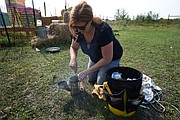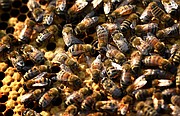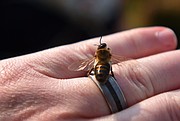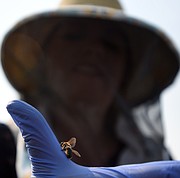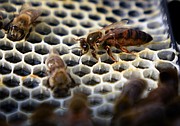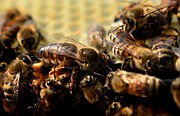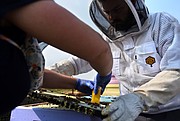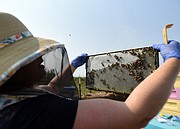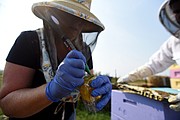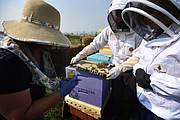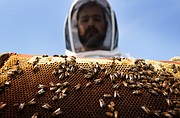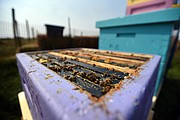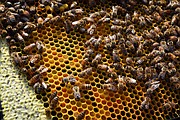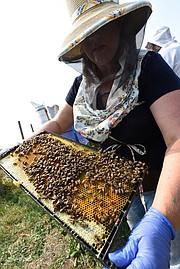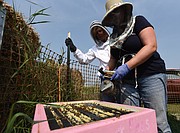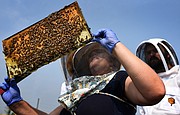Local guild helps sustain struggling bee population
The constant hum of more than a quarter of a million bees and the faint acrid smell of smoke fill the air as Angela Tollerson sets to work carefully inspecting the first of five hives on a farm east of Kalispell Monday morning. With short sleeves, blue nitrile gloves and a simple protective veil covering her head, she begins her search for the single queen among the more than 50,000 bees the hive contains. The search does not take long.
“It’s the beekeeping world’s version of Where’s Waldo,” Tollerson said. “It’s a skill you develop over time and you can get pretty good at it after a while.”
For the past two years, Tollerson, along with Ingvar Ingvarsson, has been helping area apiculture aficionados learn more about beekeeping at the helm of the Flathead Valley Beekeepers Guild.
An unofficial association without membership dues, the group of more than 50 active members is helping to sustain the struggling bee population in Montana by cultivating many of their hives with bees found throughout the Flathead Valley. By finding and extracting swarms before they can establish themselves in areas where they would become a nuisance, the group is helping maintain a delicate part of the ecosystem that has seen a severe decline in numbers over the past century.
“Our native bee population is struggling in Montana, but the bees are not alone. We have lost 60 percent of our insect mass in this country with the use of insecticides and fungicides in agriculture over the past 100 years,” Tollerson said. “Everyone loves the honey bee because it makes honey, but it also serves as the canary in the mine when it comes to the health of insects. If the honey bee is struggling, it means so is the rest of the insect population.”
One of the top honey producing states in the country, Montana is home to more native bumble bee species than any other state as well as many varieties of Apis mellifera — the western or European honey bee. While this may sound like good news for local farmers, studies have shown that modern agricultural practices have been a leading contributor to reduction of bee populations for decades.
“A lot of it has to do with monoculture, or farmers producing just one type of crop. Bees need multiple flower sources to provide a variety of pollen, so they do not do well in a monoculture environment. Bees get different nutrients from different flowers and without that diversity, they struggle,” Tollerson said. “It would be like a person trying to survive on just beef. We need different kinds of nutrients and bees are the same way.”
In addition to monoculture practices, the use of insecticides and herbicides has also been a major contributor to the population decline.
TOLLERSON’S FASCINATION with bees began at an early age. Her uncle, who was deputy commissioner of agriculture in Sonoma County, California, did a lot of work with the integration of insects and wildlife in agriculture and was a beekeeper. Beginning when Tollerson was just 4 years old, he would teach her about bees whenever she would visit. Today, she carries her uncle’s hive tool with her when she performs inspections.
Her love of bees continued as she pursued a triple major in biology, chemistry and computer science at Freed-Hardeman University in Henderson Tennessee. Her love of bees continues today as she has completed both the apprentice and journeyman beekeeping certifications through the prestigious University of Montana master beekeeping course.
Along with Ingvarsson, Tollerson has helped keep the local beekeeping community alive for the past few years, passing on her knowledge on the group’s Facebook page and website at www.flatheadvalleybeekeepers.club.
According to Tollerson, the area’s “backyard beekeepers” keep an average of three to five hives, with some taking care of as many as 10, with each hive holding approximately 50,000 bees each.
While her website does list a number of places that offer queens and bees for sale, Tollerson and the group often acquire their bees locally while helping out area residents.
In the spring or summer, a hive’s queen will often leave with half the hive to start a new one. Swarms will hang off of trees or fence posts as the bees search for a new home. People who find swarms can reach out to the club via Facebook or email so members can come collect the bees safely and find them a home before they can move into a place where they are not wanted.
Along with helping maintain the bee population, area beekeepers also enjoy the most obvious benefit of their hobby — the honey.
ALONG WITH being delicious, raw honey contains plant chemicals called flavonoids that help the body function more efficiently while protecting it against everyday toxins and stressors. Flavonoids are also powerful antioxidant agents.
“The idea is that if you eat enough locally produced honey, the tiny amounts of pollen it contains almost work like a vaccine to help build up an immunity to pollen-related allergies,” Tollerson said. “It’s not a total cure, but it can be very helpful.”
For those interested in joining the ranks of the Flathead Valley’s beekeepers, Tollerson offers a few words of advice. She suggests researching beekeeping for at least a year before purchasing bees and to read as much as possible on the subject. She posts new information as well as to do lists on the group’s Facebook page regularly and also keeps the website updated.
The group normally meets from 6:30 to 9 p.m. on the last Tuesday of the month on the second floor of the Flathead City-County Health Department, but has been conducting meetings via Facebook during the COVID-19 pandemic.
For more information, visit the Flathead Valley Beekeepers Group on Facebook or their website. Tollerson will also be teaching a two-day continuing education class on beekeeping at Flathead Valley Community College in September. Contact the school for more information.
Reporter Jeremy Weber may be reached at 758-4446 or jweber@dailyinterlake.com.




















